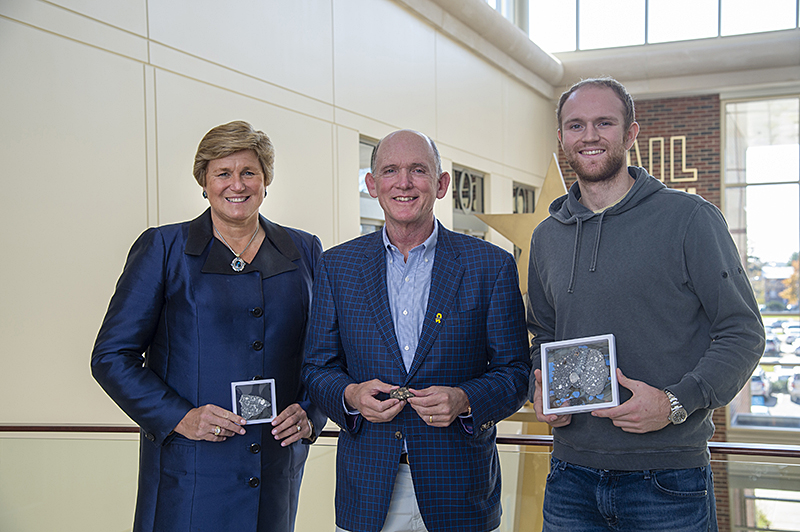September 24, 2021
Lunar meteorites now on permanent display at Purdue

The Boudreaux family - Gail, Terry and Evan - hold three lunar meteorites given to Purdue University. (Purdue University file photo/Mark Simons)
WEST LAFAYETTE, Ind. — About 35 million years ago, an asteroid hit the moon and sent chunks of rock flying into space. The chunks fell into Earth’s gravitational orbit and, some 30,000 years ago, landed on the sands of the Sahara Desert in northern Africa.
Now, some of those moon rocks, called lunar meteorites, have pride of place on Purdue’s campus, thanks to Terry Boudreaux and his family.
“I bought several kilograms of moon rock from a dealer in Morocco,” says the collector and Purdue parent, a retired health care executive who owns several lunar meteorites and Martian rocks. His son, Evan, is a 2020 graduate of the Purdue Polytechnic Institute and a former forward on Purdue’s men’s basketball team.
Boudreaux has contributed many meteorite specimens to Chicago’s Field Museum and other institutions. He decided to give three samples from the Rabt Sbayta 006 meteorite – two slices and a stone – to Purdue University because of his son. Purdue’s 2019 celebration of alumnus Neil Armstrong and the 50th anniversary of the moon landing figured into the decision as well, cementing in Boudreaux’s mind the university’s lunar legacy.
“Of all the places I could think of to donate moon rocks to, what better place than Purdue?” Boudreaux says. “It’s a very special thing to give people a piece of the moon. If you tell someone they’re holding a piece of the moon, a change comes over them. I hope Purdue students who get to see these samples have that spark — and maybe become the next astronauts on the moon.”
The specimens are classified as lunar feldspathic breccia. One lunar meteorite is on display in the Dick and Sandy Dauch Alumni Center atrium, known as the Spurgeon Hall of Spirit. A second lunar meteorite is on display in the Class of 1960 Exhibit Area of the Virginia Kelly Karnes Archives and Special Collections Research Center, housed on the fourth floor of the HSSE (Humanities, Social Sciences and Education) Library in Stewart Center.
“We deeply appreciate Terry Boudreaux and his family for this donation,” said Sammie Morris, professor and director of the Karnes Archives and Special Collections. “The meteorite on display in the Archives helps us meet our mission to advance research and learning around space exploration while serving as an object that will encourage and attract additional visitors.”
Tracy Grimm, Purdue University Libraries’ Barron Hilton Flight and Space Exploration Archivist, says, “Visitors have reacted with awe. For students, artifacts like this bring history to life. Seeing an object from the lunar surface generates excitement and enthusiasm for learners of all ages.”
Read about the Purdue specimens online.
About Purdue University
Purdue University is a top public research institution developing practical solutions to today’s toughest challenges. Ranked in each of the last four years as one of the 10 Most Innovative universities in the United States by U.S. News & World Report, Purdue delivers world-changing research and out-of-this-world discovery. Committed to hands-on and online, real-world learning, Purdue offers a transformative education to all. Committed to affordability and accessibility, Purdue has frozen tuition and most fees at 2012-13 levels, enabling more students than ever to graduate debt-free. See how Purdue never stops in the persistent pursuit of the next giant leap at https://purdue.edu/.
Media contact: Jim Bush, jsbush@purdue.edu
Note to journalists: Journalists visiting campus should follow visitor health guidelines.

